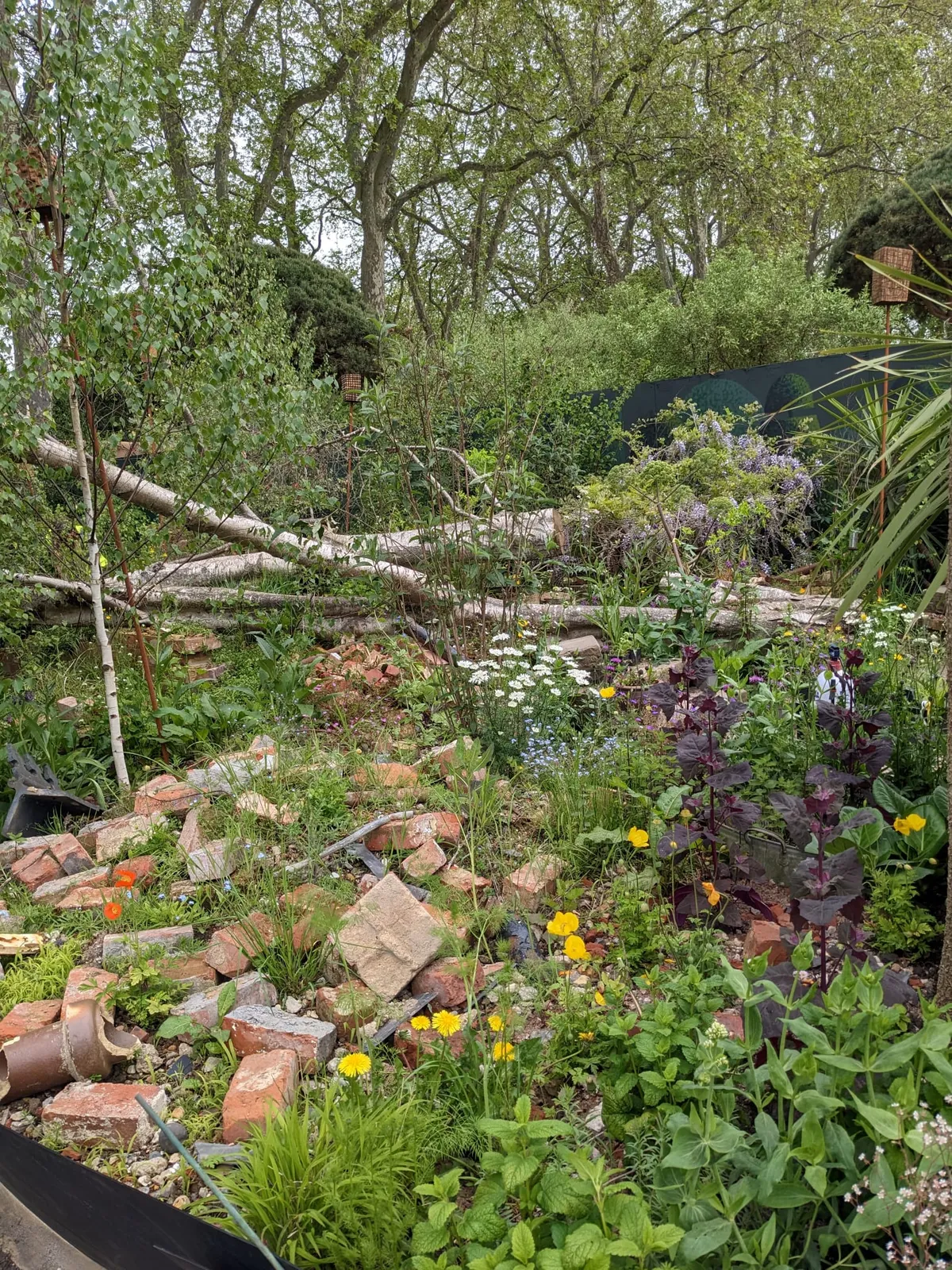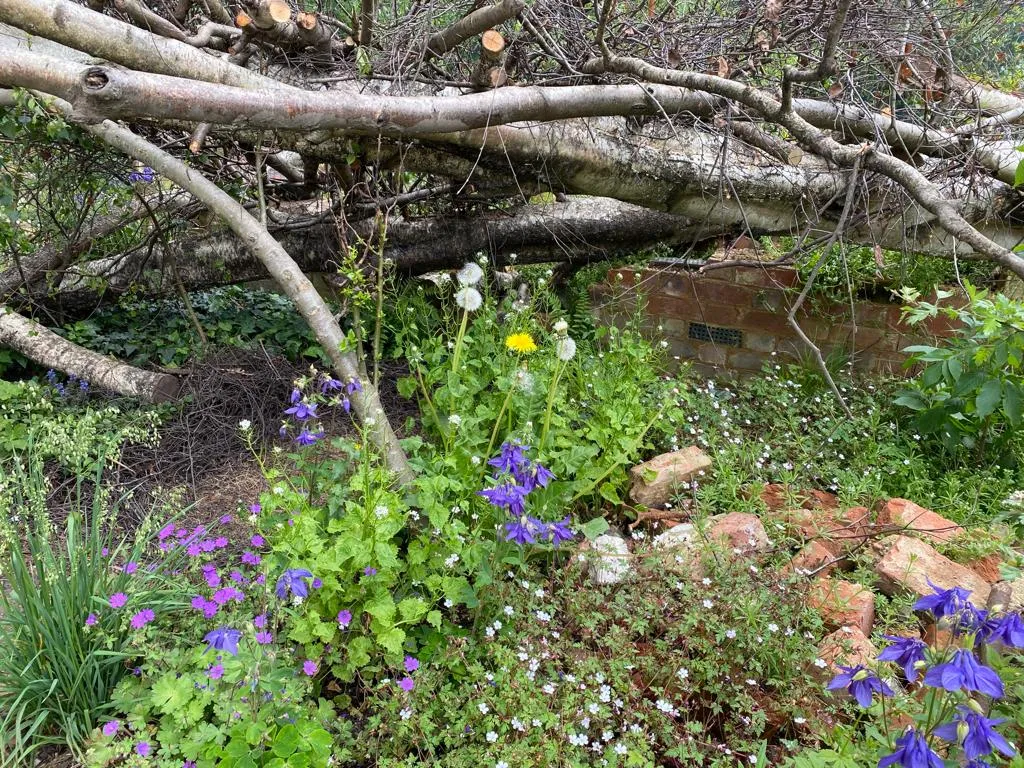From rubble wreathed in buttercups to insect-nibbled leaves, this year’s RHS Chelsea Flower Show is a flower show grappling with the gnarly realities of climate change before our very eyes. Gone is the uptight topiary and extravagant use of virgin materials so common in Chelsea’s past, replaced by a more mindful aesthetic of rewilding and reuse.
The stars of the show are The Plants Formerly Known as Weeds
The only tightly clipped topiary you’ll find at the show is on the mural painted on the hoarding-like boundary wall of Cleve West’s garden for the youth homelessness charity Centrepoint, which is the apotheosis of this new kind of wild garden aesthetic. At the centre is a ruined house; a metaphor for homelessness but also a glimpse at a future forever altered by climate change.

The stars of the show are what designer and writer Jane Owen has dubbed “TPFKAW, The Plants Formerly Known as Weeds”. Some of these firmly straddle the line between cultivated and weedy, such as the architectural yet invasive caper spurge (Euphorbia lathyris) and the pollinator magnet that is purple toadflax (Linaria purpurea), while others sit firmly in the rogue’s gallery of gardeners’ former bugbears we’re now learning to love, such as rampantly flowering dandelions (Taraxacum officinale) and creeping buttercup (Ranunculus repens). There is plenty of room for cultivated plants, too, however. For a masterclass in a subtle but stunning colour scheme, designer Sarah Price’s The Nurture Landscapes Garden leads the way, drawing its inspiration from the artist Cedric Morris’s art and his garden at Benton End in Suffolk. Its straw bale walls offer an earthy backdrop to a sophisticated palette of rusty browns, delicate lilacs and the vibrant deep purple of succulent Aeoniums.
This year's trees at Chelsea at multi-stemmed and native, but not always alive
This year’s Chelsea trees, are, as a rule, multistemmed and native, including birches, field maples and field elms, but they are not always alive. Tom Massey’s garden for the Royal Entomological Society turns huge chunks of oak into a dual-purpose sculpture and wildlife habitat, while a downed birch tree fronts Cleve West’s garden, a fractured pipe poking from the mass of its roots in recognition of its realness (it was felled to make way for a reservoir by the nursery Crocus, and will return to the site as a home for wildlife after the show).
Chelsea is “rubbish” this year, but for all the right reasons. Every designer is working hard on their environmental credentials and chipping away at their garden’s carbon footprint in the process by sourcing hard landscaping from salvage and reclamation yards. As a result, the hard landscaping comes rough and ready, be it reclaimed quarrying waste products used as paving on Tom Hoblyn’s garden for Boodles, or chunks of reclaimed concrete elevated as sculpture in Darren Hawkes’ Samaritans’ Listening Garden. Sustainable paths take a more polished form in Harris Bugg Studio’s Horatio’s Garden, where they have created a first: seamless terrazzo pathways that are both water permeable and cement-free, allowing wheelchairs and hospital beds easy passage.
The edible is centre stage at Chelsea
The cost of living crisis and the fears of our failing food security have also propelled grow-your-own to the Chelsea frontlines once more, mainly in the form ‘edimentals’ like salad burnet and wild mustard that serve a dual purpose as ornamentals we can also eat. The Savills Garden by Mark Gregory is putting edible centre stage placing a chef on site to cook lunch for a group of Chelsea pensioners every day of the show using produce harvested in situ. Whether it is medicinal herbs or edible wild plants, the concept of the edible garden is moving beyond the confines of a vegetable bed and colonising ornamental borders.

Some sections of horticulture will scan the plant lists for the majority of the show gardens where uncultivated plants such as dandelions are given star billing and wonder “is this really gardening”? Indeed, Alan Titchmarsh already has broached the subject, writing in Country Life this week, “I do worry about the dangers of pandering to current trends and allowing gardening to become predicated on a kind of laissez-faire attitude to plants that eschews any kind of human interference under the assumption that Nature is best left to herself and any muscling in on our part is to be deplored”. This is surely, though, the very debate we need right now: how do we garden - and put on flower shows - amid a climate crisis we can no longer ignore?
